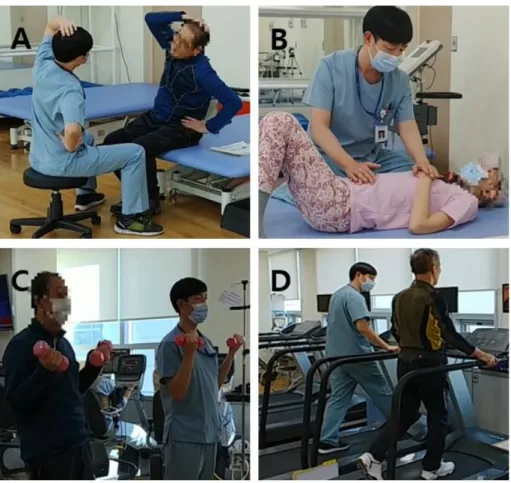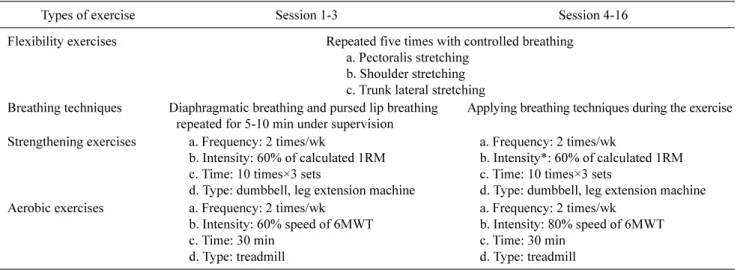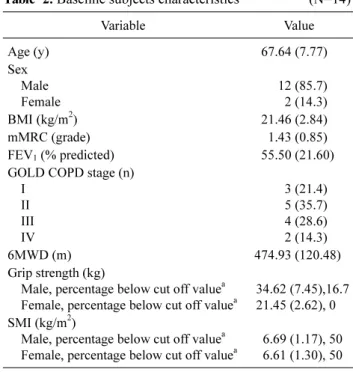http://crossmark.crossref.org/dialog/?doi=10.14474/ptrs.2020.9.2.82&domain=pdf&date_stamp=2020-6-25
Received: 17 April, 2020 Revised: 28 April, 2020 Accepted: 4 May, 2020
Corresponding author: Yong Beom Shin (ORCID https://orcid.org/0000-0001-5026-1696)
Department of Rehabilitation Medicine, Pusan National University Hospital, Pusan National University School of Medicine, 179 Gudeok-ro, Seo-gu, Busan 49241, Republic of Korea
Tel: 82-51-240-7485 Fax: 82-51-247-7485 E-mail: yi0314@gmail.com
This is an Open-Access article distributed under the terms of the Creative Commons Attribution Non-Commercial License (http://creativecommons.org/licenses/
by-nc/4.0) which permits unrestricted non-commercial use, distribution, and reproduction in any medium, provided the original work is properly cited.
Copyright © 2020 Korean Academy of Physical Therapy Rehabilitation Science https://doi.org/10.14474/ptrs.2020.9.2.82
pISSN 2287-7576 eISSN 2287-7584
Phys Ther Rehabil Sci 2020, 9 (2), 82-89 www.jptrs.org
Effects of and barriers to hospital-based pulmonary rehabilitation in patients with chronic obstructive pulmonary disease
Sang Hun Kim a , Jong Hwa Jeong b , Byeong Ju Lee a , Myung-Jun Shin c , Yong Beom Shin c
a
Department of Rehabilitation Medicine, Biomedical Research Institute, Pusan National University Hospital, Busan, Republic of Korea
b
Department of Physical Therapy, Rehabilitation Medicine, Pusan National University Hospital, Busan, Republic of Korea
c
Department of Rehabilitation Medicine, Biomedical Research Institute, Pusan National University Hospital, Pusan National University School of Medicine, Busan, Republic of Korea
Objective: The purpose of this study was to assess the effect of hospital-based pulmonary rehabilitation (PR) on exercise capacity and quality of life as well as barriers to participation in persons with chronic obstructive pulmonary disease (COPD) in South Korea.
Design: One-group pretest-posttest design.
Methods: A total of 14 patients were enrolled in this study in an 8-week PR program with two 60-minute sessions per week. The program included: flexibility exercises, breathing techniques, strengthening exercises, and aerobic exercises. The outcomes were defined as changes in the variables before and after the PR program. A change in the 6-minute walk distance (6MWD) was defined as the primary outcome, and changes in pulmonary function test, respiratory and grip strength, and the St. George’s Respiratory Questionnaire (SGRQ) about quality-of-life results were secondary outcomes. A dropout was defined as missing >3 of the 16 sessions.
Results: Patients who completed the program showed a significant improvement of 43.57±39.43 m in the 6MWD ( p<0.05), but no significant differences were noted for the other function tests. The SGRQ showed a significant improvement in the activity and total score (p<0.05). The total dropout rate was 53.3%. Newly developed symptoms, exacerbation of COPD, transport problems, and lack of motivation were major barriers to PR.
Conclusions: Our study showed that an 8-week hospital-based PR program improved exercise capacity and quality of life but had a high dropout rate in individuals with COPD. Since comprehensive PR has only recently been established in South Korea, patient motivation and education are critical.
Key Words: Exercise, Lung Diseases, Obstructive, Quality of life, Rehabilitation
Introduction
Pulmonary rehabilitation (PR) as a multidisciplinary in- tegrated program is tailored to the individual situation based on multiple assessments. It aims to improve the physical and emotional state of persons with chronic lung disease [1]. To this end, PR programs should include not only exercises to
improve physical performance, but also psychiatric assess-
ments to recognize social isolation, anxiety, and depression,
as well as interventions such as nutritional therapy and com-
prehensive education [2]. These problems are complex and
closely related to each other. If only one of them improves,
this may break the vicious cycle and positively affect the
overall situation of a patient.
According to the Korean National Health and Nutrition Examination Survey in 2008, 13.4% of the population aged 40 years and older were diagnosed with chronic obstructive pulmonary disease (COPD) [3]. COPD is an important dis- ease from a public health perspective not only because it is frequent but also because it can be prevented and treated. PR has proven benefits in persons with COPD as a non-pharma- cological treatment based on high-quality evidence [4].
Forced expiratory volume in one second (FEV
1), which can be measured in pulmonary function tests, is important for the evaluation of COPD patients but not sufficient as a selection criterion for PR. Respiratory distress, which is not necessa- rily correlated with the results of pulmonary function test- ing, reduces patients’ ability to exercise and affects their ac- tivities of daily life. Therefore, PR should be considered for COPD patients whose symptoms persist despite appropriate medical treatment or those who have confirmed exercise in- tolerance or poor quality of life [5].
While many studies have proven the benefits of PR, a 2013 survey of respiratory physicians with more than 500 hospital beds in Korea reported that more than 70% of cen- ters did not provide PR [6]. In fact, even hospitals that pro- vide PR reported that they were unable to perform the com- prehensive rehabilitation that is recommended in guidelines.
The main reason was the lack of reimbursement within the Korean National Health Insurance, which results in poor re- habilitation facilities.
With the introduction of reimbursement for PR in Decem- ber 2016, however, it became possible to establish proper re- habilitation facilities in hospitals that can provide compre- hensive PR to South Korean patients. Since the opening of its PR center in 2016, our hospital has gradually imple- mented a comprehensive PR program. The purpose of this study was to investigate the effect of an 8-week hospital- based PR program with two sessions per week on the ex- ercise capacity and quality of life in individuals with COPD and to identify potential barriers to PR.
Methods Participants
The study was a prospective single-arm intervention study at a single center. Based on a previously published study with the change in the 6-minute walk distance (6MWD) as the primary outcome, a sample size of 22 subjects was calcu- lated to be necessary for 80% power and a type 1 error of 5%
[7]. Dropouts were defined as subjects who did not partic-
ipate in more than 3 of the 16 sessions. Assuming a dropout rate of about 30%, 30 subjects were considered necessary.
Among 556 patients who were treated for COPD at our hos- pital between August 2017 and August 2018, 59 patients were referred to the Department of Rehabilitation Medicine for this study. After applying the following inclusion cri- teria: 1) >40 years, 2) symptoms such as dyspnea or exercise intolerance in their daily lives, 3) Non-smoker or patient who has quit smoking for 3 months, 4) post-bronchodilator FEV
1/forced vital capacity (FVC) <0.7 in pulmonary func- tion test, and 5) adequate pharmacological treatment follow- ing the Global Initiative for Chronic Obstructive Lung Dis- ease COPD strategy [4], 30 patients were included. Based on the exclusion criteria: 1) difficulty walking or any disease preventing improvement in walking ability, 2) uncontrolled extrapulmonary disease that could lead to hemodynamic in- stability during exercise (for example, angina pectoris, ar- rhythmia, or uncontrolled diabetes mellitus), 3) participa- tion in other clinical studies, 4) resting hypoxemia due to se- vere respiratory failure (SpO
2<90%), we excluded 29 pa- tients. Consequently, we enrolled 30 patients in the study.
Subjects who met the criteria were screened, and informed consent was obtained after a detailed description of the study procedures. Medications to improve symptoms during the study were managed by pulmonologists. The intervention was scheduled to last for 8 weeks. Ethics approval was obtained from the Institutional Review Board (IRB) of Pusan Natio- nal University Hospital (IRB No. 1706-003-056). All proce- dures of the study were performed in accordance with the amended Declaration of Helsinki. Approval included the pro- tocol and consent form used to obtain written informed con- sent from all subjects. All participants provided written in- formed consent. In addition, this study was registered at Clini- cal Research Information Service (approval No. KCT0004563).
Pulmonary rehabilitation program
An experienced physiotherapist conducted a one-hour comprehensive PR program twice a week for a total of 8 weeks. The program consisted of the following components:
1) flexibility exercises; 2) breathing techniques; 3) strength- ening exercises; and 4) aerobic exercises (Figure 1).
Flexibility exercises or chest-mobilizing exercises involved stretching the trunk and limbs while breathing deeply [8].
During inspiration, the rib cage expands and the ribs move
up. During exhalation, the rib cage contracts, and the ribs de-
scend towards the pelvis, while the arms are used to increase
the mobility of the rib cage. The following three movements
Figure 1. The program of pulmonary rehabilitation. (A) Flexibility exercise.
(B) Breathing technique. (C) Strength- ening exercise. (D) Aerobic exercise.
were repeated five times each: pectoralis stretching, should- er stretching, and lateral trunk stretching.
Breathing techniques included diaphragmatic and pursed- lip breathing during the first three visits and were repeated for 5-10 minutes under supervision. The therapist also moni- tored the use of these breathing techniques during exercise.
During pursed-lip breathing, the patient breathes air slowly and deeply into the nose with a relaxed neck and shoulders.
During exhalation, patients purse their lips and release the air slowly. The ratio of inspiration to exhalation is 1:2, and patients should avoid forced exhalation and instead breathe out slowly [9]. During diaphragmatic breathing, patients put their hands on the chest and abdomen and are instructed to breathe and focus on feeling their abdomen moving rather than their chest.
The strengthening and aerobic exercises applied the ‘Fre- quency, Intensity, Time and Type’ principle recommended by the American Thoracic Society [10]. For strengthening exercises, an intensity of 60% of the one-repetition max- imum is recommended. However, in older patients, the one- repetition maximum often cannot be measured because of musculoskeletal problems. Therefore, exercise intensity was
determined based on the four-to-six-repetitions maximum in a submaximal strength test [11]. The training was composed of three sets of 10 repetitions each. Elbow flexion was per- formed to train the arms. Sitting knee extensions were rec- ommended to train the legs and strengthen the quadriceps muscle, which often becomes dysfunctional in COPD [12].
Aerobic exercises are recommended three to five times per week by the American College of Sports Medicine and American Association of Cardiovascular and PR [5,13]. In this study, they were conducted for 30 minutes per session, twice a week. The intensity of the exercise was prescribed based on 60% of the speed for the 6MWD in each patient’s individual 6-minute walk test (6MWT) and was gradually increased up to 80% of the maximum speed. However, since the 6MWT is a submaximal test, the speed was gradually in- creased when patients did not reach a score of 5 on the Borg Category/Ratio-10 Scale. Table 1 shows the specific ex- ercise prescription for the PR program of this study.
Outcome assessments
The outcomes were defined as changes in the variables
before and after the 8 weeks of the PR. Outcome assess-
Table 1. The program of pulmonary rehabilitation of this study
Types of exercise Session 1-3 Session 4-16
Flexibility exercises Repeated five times with controlled breathing a. Pectoralis stretching
b. Shoulder stretching c. Trunk lateral stretching Breathing techniques Diaphragmatic breathing and pursed lip breathing
repeated for 5-10 min under supervision
Applying breathing techniques during the exercise Strengthening exercises a. Frequency: 2 times/wk
b. Intensity: 60% of calculated 1RM c. Time: 10 times×3 sets
d. Type: dumbbell, leg extension machine
a. Frequency: 2 times/wk
b. Intensity*: 60% of calculated 1RM c. Time: 10 times×3 sets
d. Type: dumbbell, leg extension machine Aerobic exercises a. Frequency: 2 times/wk
b. Intensity: 60% speed of 6MWT c. Time: 30 min
d. Type: treadmill
a. Frequency: 2 times/wk b. Intensity: 80% speed of 6MWT c. Time: 30 min
d. Type: treadmill 1RM: one-repetition maximum, 6MWT: 6-minute walk test.
*Recheck 1RM at 4th visit. 1RM is the maximum amount of weight that a person can possibly lift for one repetition.
ments were conducted by another well-trained physiother- apist who was blinded to all patient information. The 6MWD was defined as the primary outcome, and the results of pul- monary function tests, respiratory and grip strength tests, and quality-of-life questionnaires were evaluated as secon- dary outcomes.
Exercise capacity was measured using the 6MWT ac- cording to the American Thoracic Society’s Pulmonary Function Standard Committee guideline [14]. The 6MWT was performed on a 30-meter straight track under the super- vision of a qualified physiotherapist, and the oxygen satu- ration and pulse rate were monitored in real-time using the wrist oximeter WristOx2 Model 3150 (Nonin Medical Inc., Minnesota, MN, USA). Dyspnea and leg fatigue were checked with the Borg Category/Ratio-10 Scale before and after exercise. Pulmonary function tests and maximal in- spiratory pressure (MIP) and maximal expiratory pressure (MEP) were assessed in a standardized way using a desktop spirometer Pony FX (Cosmed, Rome, Italy) [15]. FVC was measured as the maximum inspiration and exhalation after three normal breaths.
MIP and MEP were the tests used to assess the strength of the respiratory muscles in our patients. The pressure values at maximum inspiration and exhalation were measured, and the maximum of three trials was recorded. The peak cough flow was measured with the MicroPeak peak flow meter (Carefusion GmbH, Höchberg, Germany) and recorded as the maximum value of three trials with short and forceful ex- halation after maximum inspiration.
Grip strength was measured with a Jamar hydraulic hand dynamometer (Performance Health, Warrenville, IL, USA), starting with the right hand. The subject was seated in a neu- tral position, and grip strength was evaluated in shoulder ad- duction, 90° flexion of the elbow, and with the forearm in a neutral position. The maximum value of a total of three tests was recorded. After 1 minute of rest, the left hand was tested [16]. Bioelectrical impedance analysis was performed with the InBodyS10 according to the manufacturer’s (InBody;
Biospace, Seoul, Korea) recommendations in the supine po- sition to measure muscle mass. The muscle mass (kg) in each limb divided by the square of the height (m
2) was defined as the skeletal muscle mass index (SMI). A low muscle mass was defined as less than 2 standard deviation (SD) of the mean of the sex-specific young reference group [17].
One physician assessed the symptoms and health status of patients before and after exercise. The COPD Assessment Test and the St. George’s Respiratory Questionnaire were used to evaluate the symptoms and quality of life of our patients. The COPD Assessment Test is a short and simple questionnaire that estimates the degree to which the disease affects patients’ lives. The score ranges from 0 to 40: the higher the score, the more severe the symptoms [18]. The St.
George’s Respiratory Questionnaire assesses how symp-
toms affect overall health, daily life, and the perceived well-
being of people with respiratory disease [19]. It consists of
50 items and is divided into three areas: symptoms, activity,
and impact. This questionnaire results in a score from 0 to
100, where 0 indicates the best health-related quality of life.
Table 2. Baseline subjects characteristics (N=14)
Variable Value
Age (y) 67.64 (7.77)
Sex Male Female
12 (85.7) 2 (14.3)
BMI (kg/m
2) 21.46 (2.84)
mMRC (grade) 1.43 (0.85)
FEV
1(% predicted) 55.50 (21.60)
GOLD COPD stage (n) I
II III IV
3 (21.4) 5 (35.7) 4 (28.6) 2 (14.3)
6MWD (m) 474.93 (120.48)
Grip strength (kg)
Male, percentage below cut off value
aFemale, percentage below cut off value
a34.62 (7.45),16.7 21.45 (2.62), 0 SMI (kg/m
2)
Male, percentage below cut off value
aFemale, percentage below cut off value
a6.69 (1.17), 50 6.61 (1.30), 50 Values are presented as n (%) or mean (SD).
BMI: body mass index, mMRC: the modified medical research coun- cil dyspnea scale, FEV
1: forced expiratory volume in one second, GOLD: The Global Initiative for Chronic Obstructive Lung Disease, COPD: chronic obstructive pulmonary disease, 6MWD: 6 minute walk distance, SMI: skeletal muscle mass index.
a



